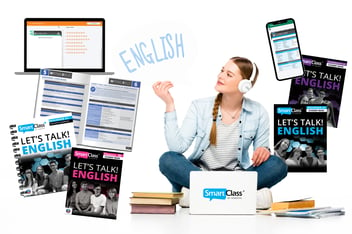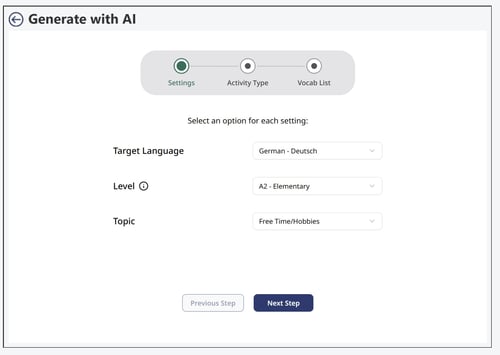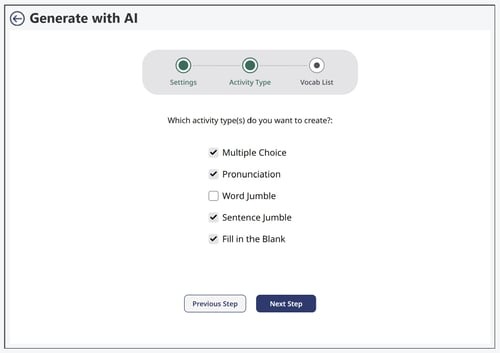
English language curriculum adoption is an important but also stressful time for educators. With so...

First day of school and she is not just a brand new student, but recently arrived from another country where English was scarce, but now it's everywhere and there is no way around it other than to chin up and make her best attempt to get through the school day. But how? Where can she look for help? The teacher smiles behind panicked eyes, but said does not speak her language, and she does not yet have the basic vocabulary, let alone the confidence to make any attempts at speaking. She is hungry, she has a headache, and she needs to figure out how she will ever keep her head above water. Does this situation resonate with you? Or maybe it is the inner dialogue of many of your students?
As teachers of newcomer English learners who must grapple with a myriad of challenges as they acculturate, on so many levels, to their new environments, there is an urgency that places a profound amount of pressure to support their immediate needs and their acculturation process linguistically, socially, academically, personally, and humanitarianly. Teachers of newcomer English learners have the added pressure of establishing a hasty rapport with their students to ensure they are able to capitalize on the critical and delicate time frame in which they capture their students' trust, despite the ubiquitous sensations of vulnerability, uncertainty, confusion, and fear that all newcomer ELs experience to differing degrees. Oh, and do not forget, with all that having been said, teachers of newcomers must also teach them grade level curriculum, deal out benchmarks and/or diagnostics and make sure they continue to add to their newcomer ELs already anxious and confusing first few days, weeks or months of mayhem while attempting to calm them with a smile and trusting affect through panicked eyes as the teachers too feel their students angst.
.jpg?width=500&height=333&name=Teaching%20Platform%201%20(1).jpg)
Ideally, teachers would be handed a customizable vocabulary-enriched toolkit in each of their students’ native languages that could serve as an olive branch that cures these uncertainties for both the teacher and student. An instructional resource where a teacher could create the perfect bank of survival English vocabulary sets, unique to their school’s organization, set up, schooling expectations, procedures and above all express to the newcomer English learners that they will be ok, that these vocabulary sets are the keys to their first steps in their journey towards fluency in the social and academic languages of schooling. Ah ha…..there does exist such a resource! The SmartClass Activity Builder provides the exact survival language olive branch, which incorporates the necessary scaffolds for building the foundational banks of vocabulary needed for newcomers’ survival. Moreover, the Smart Activity Builder can resolve the look of panic in a teacher’s eyes because now they have the perfect tool to create instructional activities unique to newcomer English learners that are vocabulary enriched sets of social and academic language necessary to help ease the transition as the students begin to take their very first leaps of faith into acculturating to a new school, a new country and completely new linguistic English reality.
There are non-negotiable vocabulary sets that are absolute variables needed to support a newcomer English learner’s first few weeks or months (depending on the individual of course) in their journey with heavy lifting of both the Academic Language and Social School Survival language which play crucial components in bridging the gap during the silent phase of acculturation to the first moments of early language production phase. Language acquisition is unique to each student; however, each student experiences the silent phase to some degree or another, where they are in full receptive mode and not yet ready to produce language or express their needs, neither academically nor socially. To better support this silent phase in second language acquisition, teachers must provide students opportunities that meet their level +1 to practice, acquire, and ultimately produce language from a tier one vocabulary set of basic survival, social, and academic language of schooling through a Tier three vocabulary set of more sophisticated social and academic language of schooling.
Social language is leveraged for students to express their basic needs, from hunger, health concerns, maneuvering the daily school schedule, attendance demands, getting on the right bus, exiting through the correct door at dismissal, understanding fire drills or shelter in place, knowing how to use their lunch cards, and what’s this Chromebook? A Google Drive? There are innumerable scenarios in which ALL students must harness and tap into a specific vocabulary set of social language to successfully go about their school day. For newcomer English learners who are in the first phases of acculturation, this vocabulary set can make or break their ability to acclimate to their new country, social cues, didactic cues, and beyond. With the SmatClass’ vocabulary set Activity Builder, teachers possess a tool that can facilitate this crucial vocabulary set to easily create customized English activities across all five language domains, reading, writing, speaking, listening, and metalinguistic connections for all students, and vitally important for their newcomer ELs.
The following table presents three tiers of vocabulary sets as they relate to social language development for English Learners (ELs) in U.S. schools — from newcomers to advanced — including examples of key terms and collocations they need to navigate daily life and social interactions at school:
|
Tier / Proficiency Level |
Description of Social Language Use |
Key Terms & Collocations (School Survival Language) |
|
Tier 1: Newcomer / Beginning |
Uses single words or short phrases to meet immediate needs; relies on gestures and visuals. |
“Can I go to the bathroom?”, “Help me, please.”, “I don’t understand.”, “My name is…”, “Where is the bus?”, “Lunch time”, “Teacher’s desk”, “Bathroom pass”, “Homework” |
|
Tier 2: Developing / Intermediate |
Begins forming simple sentences and engaging in short conversations; uses learned phrases for school routines and social exchanges. |
“I need help with my assignment.”, “Can you explain again?”, “I forgot my notebook.”, “What page are we on?”, “Can I work with a partner?”, “Line up quietly”, “Turn in your work.” |
|
Tier 3: Expanding / Advanced |
Communicates more fluently; uses idiomatic expressions, compound sentences, and appropriate tone for academic and social settings. |
“I didn’t quite catch that—could you repeat it?”, “That makes sense because…”, “I agree/disagree with you.”, “Can we go over the directions together?”, “Group discussion”, “After-school activity”, “Extra credit”, “School counselor” |

With the SmartClass Activity Builder for vocabulary sets, teachers can immediately create English Language acquisition geared activities into their digitized platform, coupled with the following non-negotiable language scaffolds needed to support Newcomer English Learners immediately as they begin their social English Language journeys:
✅Create easily adjustable activities for differing proficiency levels
✅Include authentic and reality-based visuals & images (from the very school building)
✅Upload audio messages (morning announcements, a principal's message, for example)
✅Upload videos ( of places around town, around the school, etc)
✅Metalinguistic connections and CI: all activity directions can be translated into the newcomers' native language, to ensure that teachers continue to honor the students' native language, and that students are able to understand how to go about completing activities
✅All activities are immediately graded by SmartClass’s embedded speaking rubrics, so they provide the much-needed encouragement for Newcomer English Learners in productive language confidence, helping them to fast-track the silent phase of acculturation
In the same nature, teachers can immediately create English Language acquisition geared activities into their digitized platform, coupled with the following non-negotiable language scaffolds, needed to support Newcomers immediately as they begin their Academic English Language journeys:
|
Tier / Proficiency Level |
Description of Academic Language Use |
Key Academic Terms & Collocations (Classroom & Content Areas) |
|
Tier 1: Newcomer / Beginning |
Understands and uses basic school and classroom vocabulary with heavy visual and teacher support. Repeats key phrases and labels. |
“Open your book.”, “Read the directions.”, “Circle the answer.”, “Write your name.”, “Number line”, “Map”, “Science experiment”, “Math problem”, “Teacher says…”, “Listen carefully” |
|
Tier 2: Developing / Intermediate |
Begins to use content vocabulary in simple sentences; can describe, explain, and compare using sentence frames and guided practice. |
“The main idea is…”, “I predict that…”, “First, next, then, finally…”, “According to the text…”, “The answer is because…”, “Cause and effect”, “Character traits”, “Data chart”, “Hypothesis”, “Fraction bar” |
|
Tier 3: Expanding / Advanced |
Uses subject-specific and abstract vocabulary accurately; can engage in academic discussions, write organized responses, and justify reasoning. |
“The author’s purpose is…”, “Based on the evidence…”, “I can conclude that…”, “Compare and contrast”, “Variable relationship”, “Historical significance”, “Text structure”, “Scientific method”, “Supporting details”, “Equation balance” |
In just a few clicks, Newcomer English learners are provided with customized reading, writing, speaking, listening, and metalinguistic activities to immediately mitigate the angst of entering an unfamiliar academic environment and adapting to a new language and culture.
SmartClass by Robotel’s powerful Smart Activity Builder tools allow educators to upload up to 20 English for Specific Purposes (ESP) expressions, collocations of social or academic language terms—or select from pre-built topic lists—and then choose the appropriate student proficiency level (Newcomer, Beginner, intermediate, advanced). Plus, teachers can allow students to translate directions into over 58 languages to ensure that speakers of these languages comprehend the instructions for each activity. With one click, the platform automatically generates five language-rich, autograded activities, including:
Multiple Choice reading comprehension development
Fill-in-the-blank contextualized scenarios for vocabulary development
Word jumble for syntax comprehension
Sentence jumble for dialogue and discourse development
Pronunciation activities for fluency and productive language development
This new feature saves teachers time while providing newcomers with dynamic, tailored vocabulary set practice that connects directly to their language needs.
1. How does the Smart Activity Builder support teachers working with Newcomer English learners who have limited English proficiency?
SmartClass provides teachers with an adaptive tool that automatically generates vocabulary activities aligned to thematic units and proficiency levels. This allows teachers to focus on instruction rather than material creation, ensuring that Newcomer English learners receive immediate exposure to high-frequency, survival, and academic vocabulary in context.
2. What makes the Smart Activity Builder effective for developing both social and academic language?
The platform distinguishes between social communication (everyday phrases, greetings, and classroom language) and academic vocabulary sets (subject-specific terms in math, science, and social studies). This dual focus helps students transition smoothly from basic interpersonal communication to cognitive academic language proficiency—essential for long-term success in school.
3. How does SmartClass personalize language learning for multilingual students at varying proficiency levels?
Using the educated Smart Activity Builder tailors vocabulary sets and activities to each student’s current language proficiency. It adjusts the difficulty, provides translation support in the student’s native language, and integrates pronunciation and comprehension checks—allowing every learner to progress at their own pace while feeling supported.
4. In what ways does the SmartClass reduce teacher workload while increasing student engagement?
Teachers can instantly generate interactive vocabulary sets with speaking, listening, and writing components. AI-driven auto-grading and feedback save hours of manual correction, while gamified exercises and real-time feedback keep students motivated and accountable for their own progress.
5. How does the Vocabulary Sets Builder ensure vocabulary is acquired and not just memorized?
It enforces a multimodal approach by allowing teachers to instantly pair each term with an image, audio pronunciation, and contextual video. This provides crucial comprehensible input across visual, auditory, and written domains, ensuring ELLs encounter the word in meaningful contexts for true acquisition.
6. How does the Vocabulary Sets Builder save teacher time while providing targeted differentiation for English Language Learners? It allows teachers to rapidly create one vocabulary set from any source material and instantly generate five different activity types (e.g., matching, speaking, writing). This streamlines differentiation, eliminating manual resource creation and giving teachers targeted tools for reinforcement based on individual student needs.
7. Why is SmartClass Smart Activity Builder a sustainable solution for districts facing staffing shortages or a lack of ESL-certified teachers?
SmartClass by Robotel AI serves as a Virtual Pedagogical Mentor, offering ready-to-use, standards-aligned vocabulary lessons that require minimal teacher preparation. This empowers substitute teachers or general educators to confidently deliver quality instruction, ensuring that language acquisition continues seamlessly—even in the absence of certified ESL staff.

Ultimately, the success of Newcomer English Learners hinges on consistent, high-impact, and specific vocabulary set instruction. The challenge for educators is finding the time to deliver this level of quality amid endless administrative tasks. This is where the Smart Activity Builder provides the definitive solution to create ideal, customizable vocabulary sets for both social and academic language scenarios. By leveraging the power and efficiency of the Smart Activity Vocabulary Builder, teachers can significantly maximize the crucial first encounters with the English Language for their newcomer students, supporting the initial, very vulnerable silent phase of acculturation. This critical shift in focus on specific social and academic vocabulary sets allows educators to move past logistical burdens and concentrate on what truly matters: facilitating meaningful language interactions with their EL students to accelerate authentic language acquisition for immediate application in both the academic and social endeavors their students will face as they navigate through their school day.


English language curriculum adoption is an important but also stressful time for educators. With so...

In today’s classrooms, multilingual learners face the challenge of acquiring academic language...

The COVID-19 pandemic has brought unprecedented challenges to education systems worldwide. In the...
Leave a comment